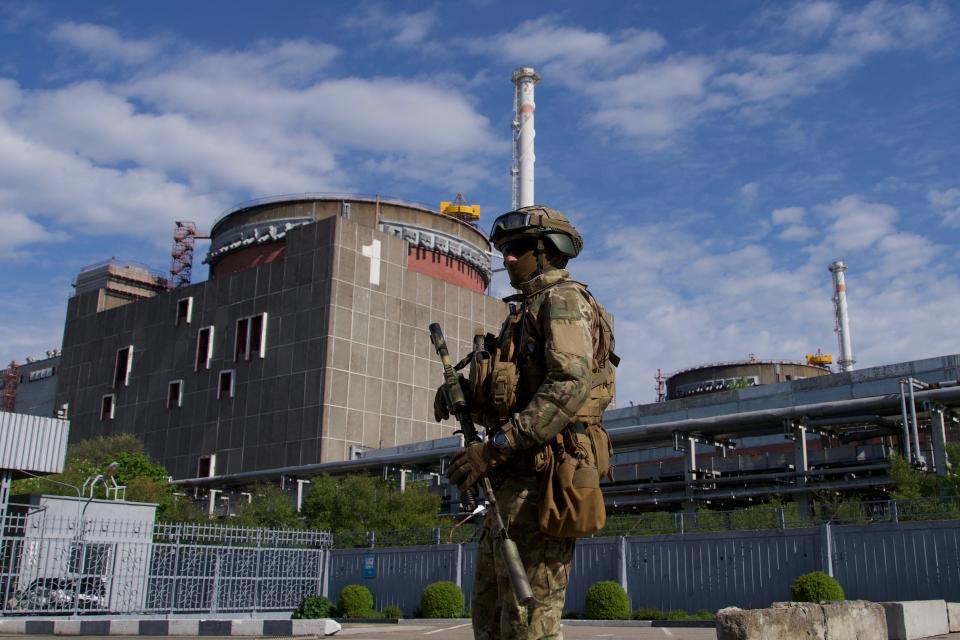Russia was making big plans for Ukraine's nuclear power plants before its invasion fell apart

Russia launched its attack on Ukraine in February 2022 with plans for a quick victory.
Those plans depended in part on seizing Ukraine's nuclear power plants and using them for leverage.
Russia's ambitions for those plants were foiled when Ukraine fended off the initial attack.
When he launched his invasion, Russian President Vladimir Putin had ambitious goals for Ukraine.
Within three days to a week of attacking, Putin planned to capture Kyiv, topple Ukraine's government, and demilitarize Ukrainian forces.
According to an analysis of the first five months of the war by the Royal United Services Institute, a British think tank, the Russians had big plans to use Ukraine's nuclear power plants to help make it all happen.
3 Russian plans

According to the RUSI report, Russia's war plans viewed Ukraine's nuclear power plants as a means to achieve Moscow's larger aims. Key to that planning was southern Ukraine's Zaporizhzhia plant, which is Europe's largest.
The Kremlin's plan envisioned three uses for the Ukrainian nuclear power facilities once the invasion was underway.
First, Moscow planned for Ukrainian nuclear power facilities to function as bases for Russian troops and their equipment as well as ammunition depots. Russian officers were also to set up command-and-control posts within the premises of those nuclear facilities.
The second function the Kremlin envisioned for the nuclear facilities was to gain control over Ukraine's energy system. Nuclear power generates more than 60% of Ukraine's electricity. Thus, by controlling the nuclear facilities, Moscow would have influence over Ukraine's population and economy.
Finally, Moscow wanted to control the Ukrainian nuclear facilities so as to have "leverage for blackmailing" European countries. By threatening Europe with radiation pollution from potential accidents, the Kremlin hoped to deter direct or indirect foreign intervention.

Moreover, to deal with any Ukrainian provinces that refused to cooperate with the proxy government Moscow was planning to install, the Russians planned to weaponize the captured nuclear power plants to cut off electricity to those regions.
Moscow's goal was the "denuclearization" of Ukraine through the capture and control of its nuclear power plants, along with the destruction of Ukraine's national identity and of Ukraine's military forces and defense industry, according to the RUSI report.
Moscow also incorporated Ukraine's nuclear power facilities into its information operations.
In trying to justify the illegal and brutal invasion of its neighbor, Russia went to extremes, calling for "de-nazification" of its neighbor and making allegations about the presence of "American Pentagon biolaboratories."
Moscow also seized on Ukraine's peaceful nuclear power program — a legacy of the Soviet Union — to accuse Kyiv wanting to restore its nuclear weapons program and thereby threaten Russia. Ukraine was left with nuclear weapons after the Soviet Union dissolved, but leaders in Kyiv, who didn't have the ability to use those weapons or funds to maintain them, gave them up in 1994 in exchange for security assurances from the US, the UK, and Russia.
Fighting in a nuclear plant

Although Russia's military failed to achieve any of its primary invasion objectives, it did manage to capture the Zaporizhzhia plant.
In a firefight recorded by cameras at the plant, Russian forces are seen storming and capturing Europe's largest nuclear power plant, partially achieving Moscow's goals.
Over the following weeks and months, the Russian military moved more troops into the area and housed them on the plant's premises.
Fighting in the region around the plant continued, and artillery fire frequently landed in and around the facility. Russian troops also stored equipment and weapons in and around the Zaporizhzhia plant.

Russian forces still control the Zaporizhzhia plant, but Ukraine has fended off Russian attacks on its other nuclear power facilities.
Russian forces tried to capture the Pivdennoukrainsk plant in southern Ukraine but were repelled, though the facility came under artillery fire in the fall that struck a few hundred yards from its nuclear reactors.
After almost a year of fighting and the deaths of tens of thousands of Russian troops, it's evident that Putin's plans for Ukraine failed miserably, and there are other signs that Ukraine and the world thinks those ambitions are thwarted for good.
The International Atomic Energy Agency recently established a permanent presence at the Pivdennoukrainsk plant, a sign of confidence in Ukraine's ability to hold off future Russian attacks.
Stavros Atlamazoglou is a defense journalist specializing in special operations, a Hellenic Army veteran (national service with the 575th Marine Battalion and Army HQ), and a Johns Hopkins University graduate. He is working toward a master's degree in strategy and cybersecurity at Johns Hopkins' School of Advanced International Studies.
Read the original article on Business Insider

 Yahoo News
Yahoo News 